
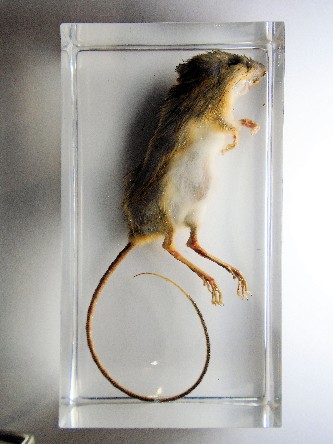

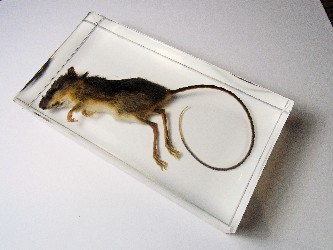

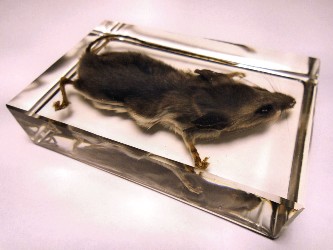
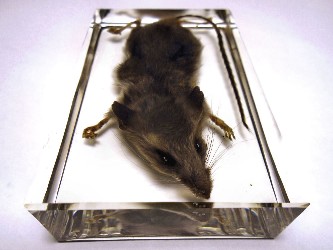



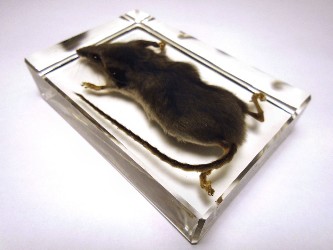



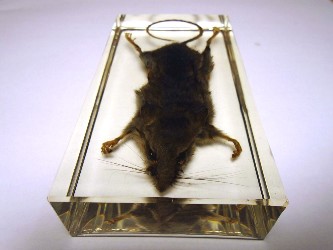
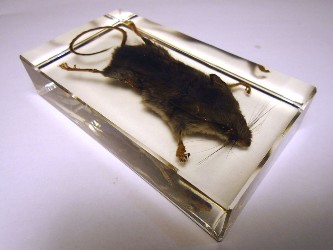

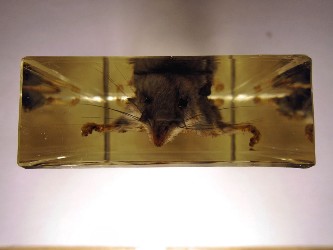
CLEAR RESIN ENCAPSULATION
 |
 |
 |
 |
 |
 |
 |
 |
 |
 |
 |
 |
 |
 |
 |
 |
 |
 |
|
HANDBOOK OF THE MAMMALS OF THE WORLD
CLICK FOR DOWNLOAD (PDF) --------------------------
KINGDOM : Animalia
PHYLUM : Chordata
CLASS : Mammalia
ORDER : Rodentia
FAMILY :Cricetidae
SUBFAMILY :Neotominae
GENUS :Peromyscus
SPECIES :P. Maniculatus
--------------------
Order Mega/Micro chiroptera
|
DEER MOUSE
Peromyscus maniculatus is primarily a nocturnal species.Peromyscus maniculatus occupies many different ecological zones throughout its range. Deer mice can be found in alpine habitats, northern boreal forest, desert, grassland, brushland, agricultural fields, southern montane woodland, & arid upper tropical habitats. Also, P. maniculatus is found on boreal, temperate, and tropical islands. However, its most common habitats are prairies, bushy areas, & woodlands.
A mature male, a few mature females, and several young constitute the basic social unit of the deer mouse. In the winter, groups of ten individuals or more of mixed sexes and ages may huddle together in nests to conserve heat.
The species has 61 subspecies. They are all tiny mammals that are plentiful in number. The deer mouse is a small rodent that lives in the Americas and is closely related to the white-footed mouse, Peromyscus leucopus. Because the two species are extremely similar in appearance, they are best distinguished through red blood cell agglutination tests or karyotype techniques. The deer mouse can also be distinguished physically by its long & multicolored tail. Deer mice are very often used for laboratory experimentation due to their self cleanliness and easy care.
The deer mouse is small in size, only 8 to 10 cm long, not including the tail. Weighs between 10 and 24 grams. They have large beady eyes and large ears giving them good sight and hearing. Peromyscus maniculatus has soft fur which varies in color, from gray to brown, but all deer mice have a distinguishable white underside and white feet. Deer mice tails are covered with fine hairs, with the same dark light split as the fur on the rest of its body.
Deer mice are nocturnal creatures who spend the day time in areas such as trees or burrows where they have nests made of plant material. The pups within litters of deer mice are kept by the mother within an individual home range. Deer Mice typically live in a home range of 242 to 3000 square meters. Although deer mice live in individual home ranges, these ranges do tend to overlap. When overlapping occurs, it is more likely to be with opposite sexes rather than with the same sex, as male deer mice have a much greater home range than the much more territorial females. Deer mice that live within overlapping home ranges tend to recognize one another and interact a lot.
Deer mice perceive their environment through keen senses of hearing, touch, smell, and vision. They communicate using tactile, visual, chemical, and auditory signals. They groom one another, posture, emit pheromones, mark their territories with scent, and make a variety of squeaky vocalizations. Sometimes when disturbed they drum their front paws rapidly up and down against a hard surface; this may serve as a warning signal to other deer mice.
Deer mice are important prey for snakes, owls, minks, martens & other mustelids, as well as skunks, bobcats, domestic cats, coyotes, foxes, & ringtail cats.
Like other Peromyscus species, it can be a vector and carrier of emerging infectious diseases such as hantaviruses and Lyme disease. Deer mice are also parasitized by Cuterebra fontinella.
|